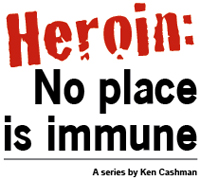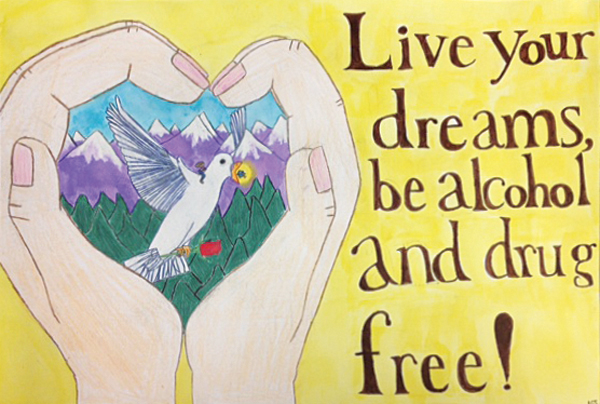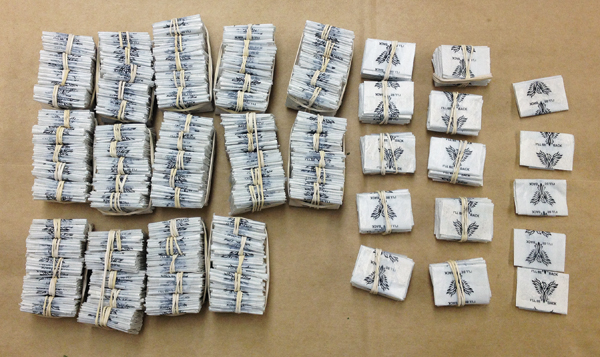 From the beginning we assumed there was heroin in Cornwall. It was everywhere else, and we believed that no community was immune.
From the beginning we assumed there was heroin in Cornwall. It was everywhere else, and we believed that no community was immune.
It didn’t take long for our belief to be confirmed. As soon as Part I of the series hit the news stand, a reader called and agreed to come into the office. He told us that his son had been a heroin addict until 2012. The son had known people in Town with the same problem, and had been able to buy heroin in Cornwall, as well as in Washingtonville and Newburgh.
We heard a similar story from Caylah Matos, a 2012 NFA graduate, who moved to Cornwall after graduation. She had been using pain killers since 10th grade. But in her new location, she escalated to heroin, which she bought from a man she would meet in a parking lot on Quaker Avenue.
On the morning of the Little League Parade, a young parent stopped me to say she had seen needles and empty heroin bags on a trail on Storm King Mountain. “My kids are in elementary school,” she said, “but I’m talking to them about drugs now.”
And that’s the motivation for this series — not to alarm people, but to make them aware and vigilant. For Part III, we spoke to people who learned about heroin after a family member became addicted.
The gentleman who called on the first day gave us several on-line resources. His son had moved out of the area after spending a year in a rehabilitation program.
The father believed that it takes that long to have a valid chance of recovery. “And even then,” he said, “there’s a depressingly sad number of relapses.”
We didn’t talk about why some people jump from painkillers to heroin and others don’t. But we did talk about what happens next. Once the user is addicted to heroin, the motivation changes. “They’re doing it just not to feel bad,” my visitor told me. “Their social world closes down. [Taking drugs] ceases to be a social event or a rational decision. It’s like having a cancer.”
With that insight, the gentleman believes that addicts need treatment rather than incarceration. He hopes to some day arrange a forum in Cornwall so people can appreciate the scope of the problem.
Brian Green (not his real name) knows the scope of the problem. He tried many of the same pills as his younger brother Stu, who was featured in last week’s issue. But, unlike his brother, Brian never switched to heroin.
Stu’s addiction put a burden on the rest of the family. His brother would spend 50 minutes out of his lunch hour, driving home to check on what was happening at the house. But looking back on those days, his brother feels no resentment. “Doing heroin doesn’t mean you’re a bad person,” he told us, “But it can make you do bad things.”
As the parent of a heroin addict, Jose Matos admitted to being angry. “It was hard for me to speak about it,” he acknowledged when we met at Dunkin Donuts. “I had the feeling that I failed.”
His daughter Caylah had been an honor student. She had made three trips with her church to help orphans in Guatemala. Caylah was a role model for others. But she didn’t see herself that way.
She started painkillers in 10th grade, and tried heroin after graduation. By the fourth dose, she was doing it every day. Caylah lost two jobs and cleared out her bank account. That’s when she confided in her parents and tried quitting on her own. It lasted for two weeks.
At a time when Caylah’s friends were leaving for college, Caylah’s father was taking her to rehab in Long Island. He felt cheated, as if something had been stolen from him.
But that was a year ago. Caylah spent nine months at Long Island Teen Challenge and then three months at Women at the Well in Tennessee. She had just returned home and was with her father when we met last Monday.
“I wasn’t ready to come home until I came home,” she admitted. Her assessment sounded familiar. Other people had told us that it takes a long time to cure an addiction.
While she was away, there was time to think. She couldn’t remember what she was like on heroin, but she knew that she just wanted to overdose.
“Are you kidding me?” she says today about her desire to leave this world. “I don’t see myself as the same person…. Back then there was no point. I just wanted to be high and be by myself. Today I realize I have a purpose. That God is real and He has a purpose for me.”
Caylah has her old job back and is hoping to start college in the fall. Mr. Matos, once again a proud father, has written a book to help other people understand who they are and avoid a lifestyle that leads to spiritual apathy.
The book, “Spiritual Quadrants,” will be available on Kindle on April 18, or people can download it as a free app to their mobile devices.
Speaking of his daughter’s experience, Mr. Matos is suddenly upbeat. “We can find the good in it,” he says, “and use it for good. Nothing has to stay the same.”



